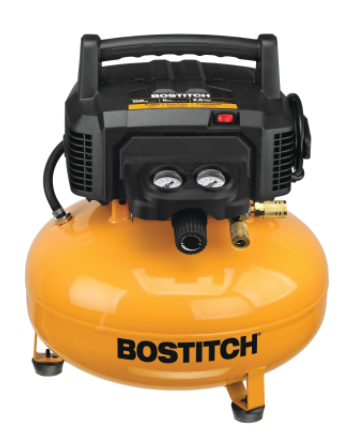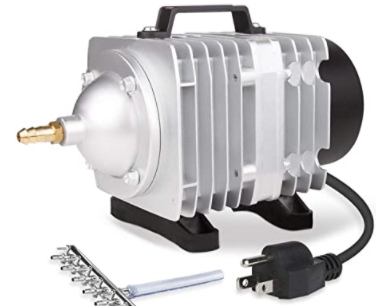I'm really frustrated with my air compressor, it is just too darn loud! I have a Stanley Bostitch BTFP02012 6 gallon pancake compressor that is rated at 2.6 SCFM at 90 PSI with a peak pressure of 150 PSI.

The claim is that it produces 78.5 dBA of noise but that must be at 60 feet away in an open field. In my enclosed 2 car garage my dB meter is recording 92 dBA at 5 feet and my watch is sending me notifications that it is too darn loud. I don't run this without ear protection it is just too much. As a quick experiment I tossed it into a heavy duty cardboard box and closed the lid, mostly because it was easy to grab. That actually cut the noise by almost 10 dB but with the hearing protection removed it was still painfully loud, and much too loud to talk over.
I could try to build a small enclosure for the compressor and sound proof it. However this compressor runs very hot and I'm afraid it would be hard to get enough ventilation to keep the compressor safe while still reducing the volume by the 20 dB needed to bring this down to a manageable volume. Alternatively I could push the compressor outside and let the neighbors worry about the noise. However that does not sound like the neighborly thing to do, especially because I'm only 20 feet or so from my neighbors house.
That got me thinking about what my air needs really are. So I ran some experiments. First I drained the tank completely and timed how long it took to fill back up, taking readings at intervals of 30 psi. I came up with the following data. I used this CFM calculator to help with the math.
| psi interval | time(s) | cfm |
| 0-30 psi | 14s | 7.9 cfm |
| 30-60 psi | 26s | 3.8 cfm |
| 60-90 psi | 33s | 3.0 cfm |
| 90-120 psi | 37s | 2.7 cfm |
| 120-150 psi | 44s | 2.23 cfm |
I also calculated the cut in pressure at 120 psi and cut out at 150 psi. Interestingly enough refilling the tank from 120-150 took only 31 seconds (2.7 cfm), I suspect the faster fill time has to do with the fact the pump had cooled back down. Anyway from these numbers we can estimate that the compressor can produce 3.8 cfm at 30 psi and 2.7 cfm at 90 psi, that lines up well with the rated specs. It is always nice when that happens.
Next I used one of my 2 mm test nozzles and set the air regulator to 30 psi (with the air to the nozzle turned off). Opening the air it took 65 seconds to drain the tank from 145 psi to 120 psi, that works out to 1.3 cfm of air flow. Finally I put my over the lens nozzle on and re-ran the test with all that extra air leaking around the lens. That took 37 seconds or 2.21 cfm of air. I still need to see how long it takes the compressor to catch up when the nozzle is loosing 2.21 cfm of air, chances are it will basically be running all the time.
If I measured this right then I need something between 1.4 and 2.3 cfm depending on how well I can seal up the nozzle. CFM without pressure is a bit meaningless, it looked to me like the regulator was outputting around 10 psi with the nozzle in place and the air actually moving. That is much higher than the 5 psi that aquarium air pumps can produce, but I'm not sure exactly how all those relate to each other.

On paper this compressor could cover the flow rate. It is rated at 2.5 cfm at 4.3 psi and claims 60 dB volume all for $60. I'm a bit skeptical that it will live up to its given specs, and it would probably be better to have a bit of extra headroom just in case, so this compressor may be a better choice with 3.9 cfm at 5psi for $88.
Anyway these fish pumps probably have enough flow to get the job done, and the rumor is they are quieter than a proper compressor. They would be running at or near there limits the whole time you are cutting, but they should get the job done. Keep in mind that my compressor could go much higher than 30 psi, we could easily get a lot more air out of it. There is an upper limit on this however, eventually you need better quality tubing and connectors just to keep it all together. I experimented with 60 psi and my system popped apart.
I'm going to investigate plugging up the lens side of the nozzle to reduce the air loss. If nothing else that will give my compressor a bit of a break so it is not cycling quite as often when cutting. However the pressure is rather intense, I found it difficult to plug the hole up with my thumb when I took the nozzle off the laser, I'm not sure if a bit of silicon will hold together.
 David Tucker
David Tucker
Discussions
Become a Hackaday.io Member
Create an account to leave a comment. Already have an account? Log In.